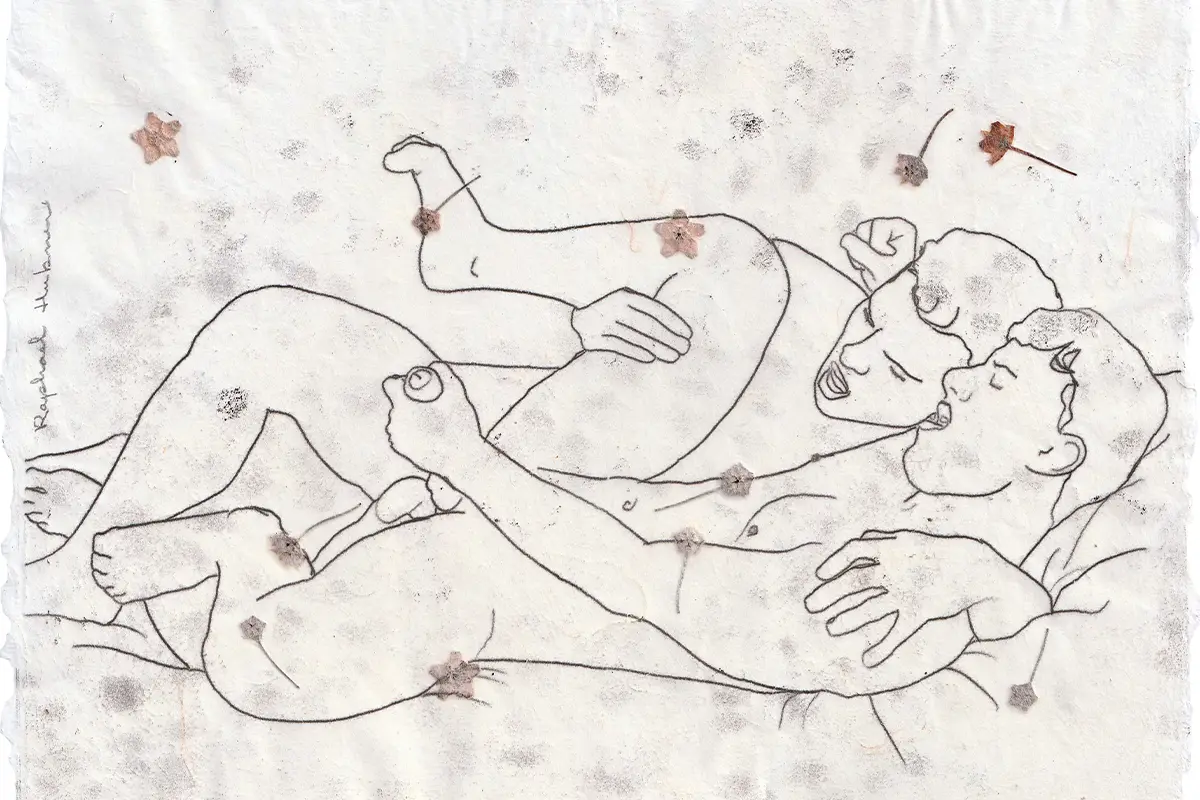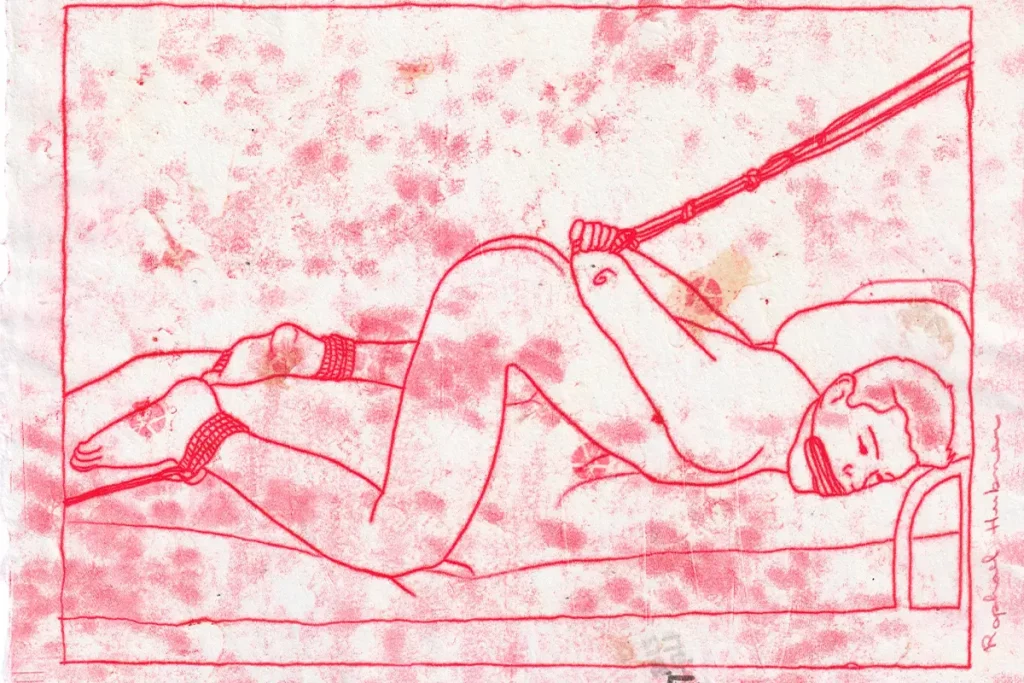The Brazilian artist draws sex positions men can perform in public and private spaces. Raphael Hubner homoerotic art outline men intimacy and sex in conservative Brazil
Raphael Hubner drawing modernizes Kama Sutra. Homoerotic art letters from Brazil
Raphael Hubner draws sex positions men can perform in their bedrooms and at public cruising and orgy parties. Using pencils, he forms bold lines to accentuate the diverse body sizes and shapes of these men. He hints at the girth and length of their cocks that penetrate holes or are sucked by lips using outlines. His collection of drawings on paper, monotype, and wood modernizes the Kama Sutra, the ancient Indian Sanskrit text on sexuality, eroticism, and emotional fulfillment in life. Raphael’s drawings, however, veer more towards the techniques and style of queer expressionism. Rather than detailing the colors of the figures and the environments they are in, the men emerge sharply with as limited details as possible.
Austrian Expressionist Egon Schiele’s influence to Raphael Hubner – sexual exploration through drawings
Raphael studied fashion design, used his own body as his canvas and medium for his clothes, and spent years working on costumes and set design for television, cinema, and theater productions. After a while, he stumbled upon performance art. Through body movement, he scrutinized the details of the male figure, the lines, arches, and slopes that demarcate the body as he twisted, crouched, and bent his own to the sound of music. Not long after, he came across the self-portraits of the Austrian Expressionist painter, Egon Schiele.
«His work deeply marked me. At the beginning, my works were entirely expressionistic, true investigations of my own body», Raphael tells Lampoon. Schiele’s artworks are underlined by twisted, elongated, stretched, and naked bodies, and more often, versions of himself. The faces and positions of the male figures are either painted with rosy cheeks, tilted heads, angular jaws, keeled bodies, and round eyes, or melted faces, amorphous physiques, intertwined bodies, negative spaces, incompleted lines, and deconstructed forms.
Raphael Hubner’s fascination with male bodies, queer and homoerotic art
These elements are visible in Raphael’s drawings. His are minimal, and where the sex takes place is reduced to references such as a blanket or the railings of the ship. But the faces, body language, and gestures of the male figures show emotions: pursed or parted lips, closed or squinted eyes, hands reaching for cocks in an orgy, wrists tied behind the back, mouth gagged with a ball, men masturbating in line waiting for the kneeling man to suck them, and ropes strapped around restraining bodies.
Raphael is more than just fascinated with male bodies; he peruses and sketches them to explore, understand, and showcase himself and how he sees male intimacy in sex. «It’s the subject I pay the most attention to and feel the most intimacy with. It’s the driving force that turns my desire into art, and my art into desire. They are intrinsically connected», Raphael says.
«Brazil is a conservative country», says Raphael Hubner
Much of his work, if not all, is rooted in his personal experiences as a gay man living in Brazil, a constitutional-republic country with conservative values towards queerness. «Brazil is a conservative country, and we are still fighting for basic rights. São Paulo, being a global city, is more accepting of diversity. But in general, one needs to be vigilant, as there are still places where we are merely tolerated», Raphael opens up to Lampoon. Years have gone by, and notable constitutional laws in the country can suggest progress for the LGBTIQA+ community in Brazil.
In a report by Outright International, the non-governmental organization states that same-sex marriage has been legal in Brazil since 2013, same-sex couple adoption has been legal since 2010, and there has been a process for legal gender recognition in place since 2009. Brazil’s Supreme Federal Court also criminalized discrimination on the basis of sexual orientation and gender identity in 2019, and the country has a a 1999 law that prohibits psychologists from conducting conversion therapy. The report says that while a judge overturned the law in 2017, the Supreme Court reversed the decision in 2020, making the banstill in effect despite these legal protections.
Regardless of these feats, Brazil still accounts for one of the highest murder rates of LGBTIQ people in the world. A case study released by the Observatory of LGBTI+ Deaths and Violence in Brazil documents that in 2022 alone, there were 273 deaths and violence against LGBTI+ people in Brazil (228 were murders, 30 suicides, and 15 other causes).
Growing up in a prejudiced and moralistic society – Raphael Hubner queer existence
Raphael may have seen these constitutional changes himself, but they did not subdue the weariness he felt growing up. One way he describes his upbringing is as living in «a prejudiced and moralistic society». For much of his childhood, he felt that the community he was in posed a danger to his being open about his sexual orientation, despite his family’s support. He was forced—and so he forced himself too—to suppress his actions, movements, and words that traditional men might not typically do and say.
When he was in his teen years, the situation worsened, and «judgments came from everywhere», says Raphael. He conformed to masculinity for a long time, driving him to come out late and not recognize his queer identity. «Everything I did until then was secret, and all the pressure built up during those years. I freed myself from all the stigmas that were imposed on me. Today, my work portrays everything I was taught to see as wrong. It’s my freedom, which obviously comes at a cost, but I’m willing to take the risk», he says.
Raphael Hubner focuses on mastering his craft
During the times he needed to fit in, and more so now that he is out, art and drawing had Raphael’s back, a way for him to also ponder and confront his experiences and himself. His drawings of men at sex and erotic queer expressionism may recount the secrecy queer men around him and he himself had to be subjected to so they could avoid being judged and aggravated within their social circles. But over time, Raphael focuses more on mastering his craft.
«My first erotic drawing was a doodle in my process notebook. My most recent artwork is a monotype from my sailor collection. Back then, I didn’t fully embrace the title of artist. Maturity comes through practice, and from practice, you learn that perfection is never truly attainable. Today, I work with much more ease and confidence», he says.
Queer literature that informs Raphael Hubner’s practice – queer as fuck
His fascination with male figures has grown and lured Raphael to pursue art and read literature about queer eroticism, whose texts have influenced the way he draws and even the settings of the cruising and orgies on his canvas. «I read a lot. I believe much of what I read directly influences what I’m producing. I seek out icons from the collective gay imagination, but I also take a contemporary approach and delve into the world of fetishes. The most fascinating aspects come through commissions. It’s like telling stories. I work on everything from intimate moments to cute family portraits with pets», he says.
In 2022, the Brazilian artist explored Shunga, a series of Ukiyo-e, or Japanese woodblock prints, that depict sex and pleasure in the everyday life of Japan. The term shunga can be translated to spring pictures and bears the symbolism of sexual encounters in a budding romance. It may be typical for Shunga illustrations to cover straight commoners in Japan, but Raphael discovered Shunga paintings of men fornicating in their traditional Japanese clothing. He even found one where a Buddhist monk was humping over a figure below him, his cock already sunk deep into the man’s back.
In early 2023, he studied the queer sailors in the paintings of Charles Demuth, who conducted exhibitionism while on board a ship. For Raphael, sailors here can be seen as queer icons that aim to evoke the lives of men living in isolation but at close quarters and whose intimate lives were once clandestine out of necessity «because homosexuality was and, in many places still is, considered both a sin and a capital offense», he writes.
Raphael Hubner on his homoerotic drawings: «People can understand that love between equals is as valid as any other»
«My love for literature has helped me throughout my life and is an inexhaustible source of creativity. Currently, I am reading O Cortiço by Aluísio Azevedo, a Brazilian classic published in 1890. In it, we encounter Albino, an effeminate man who works as a washer, wears an apron as a skirt, prefers the company of women, and is always pejoratively ostracized by the society of the time. He is possibly the first gay character in our literature. We also have the book Bom Crioulo by Adolfo Caminha, written just five years later. It portrays the tragic love between two men aboard a Navy warship. This is a remarkable book for being one of the first works to openly address homosexuality in Brazil», he tells Lampoon.
The Brazilian artist openly shares his artworks online and hopes that «people can understand that love between equals is as sublime and valid as any other. They feel desire, but they also feel represented. It’s political; it’s a statement: We exist, and we will always exist».
Raphael Hubner, queer artist
Raphael Hubner is a contemporary artist who investigates the male figure. He has worked in various mediums throughout his career, including drawing, printmaking, installation, and performance art. His work engages with themes such as identity, desire, relationships, memory, and visibility.
Hubner creates personal narratives, influenced by his experiences as a queer man in South America. His homoerotic drawings capture expressive figures, energy, and vitality with a precise technique. They are minimalistic yet compelling, devoid of ornamentation. His works can be found in Brazilian art exhibitions and in the homes of collectors around the world.




















